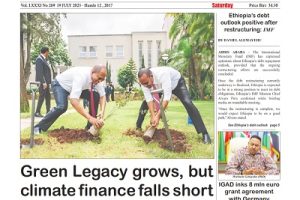
Climate change is a global crisis that transcends national boundaries. It is a problem that needs global collaboration and coordinated responses at all levels. On December 12, 2015, world leaders met in Paris for the United Nations Climate Change Conference, often known as COP 21, to address climate change and its harmful consequences. This pact is commonly referred to as the Paris Agreement.
The Agreement sets long-term goals for all nations, including significantly reducing global greenhouse gas emissions to keep global temperature rise to well below 2°C above pre-industrial levels, and pursuing efforts to keep it to 1.5°C above pre-industrial levels, recognizing that this would significantly reduce the risks and impacts of climate change.
It also evaluates the collective progress toward attaining the aim of this agreement and its long-term goals regularly. It gives funding to developing nations to prevent climate change, boost resilience, and improve their ability to adapt to climate consequences.
The Agreement is a legally binding international treaty. It entered into force on 4 November 2016. The Paris Agreement now has 194 signatories (including the European Union (EU)). The Agreement includes pledges from all nations to decrease emissions and collaborate to adapt to the effects of climate change, as well as a call for governments to enhance their commitments over time. The Agreement creates a framework for transparent monitoring and reporting of countries’ climate targets, as well as a mechanism for rich nations to assist poor nations in their climate mitigation and adaptation efforts.
The Agreement establishes a long-term framework that will guide the global effort for decades to come. It is the first step toward a future with zero emissions. The Agreement’s implementation is also critical to achieving the Sustainable Development Goals. This agreement demonstrates that a country’s development should include at least three complimentary goals: supporting economic development and growth, reducing and avoiding future emissions, and building resistance to climate change.

Because, within the framework of the Agreement’s temperature objective, the agreement sets a worldwide goal on adaptation that aims to build resilience, increase adaptive capacity, and decrease susceptibility to climate change. The objective is to considerably enhance domestic adaptation endeavors, including assistance and global collaboration. It acknowledges that adaptation is a universal difficulty that everyone must encounter. In addition to creating and carrying out national adaptation plans, all parties involved in the adaptation process should submit and update an adaptation communication detailing their goals, requirements, plans, and course of action regularly. It is important to acknowledge the adaptation efforts made by developing nations.
Despite the agreement, Ethiopia’s successive governments have worked to balance the effects of climate change with growth to reach lower-middle-income status. To achieve this aim, they also adopted various economy-wide sustainable developments, green, and climate-resilient initiatives, and policies.
The country has developed several programs to combat climate change and construct a climate-resilient economy. Greening and farming concerns for sustainable agricultural practice, improving effective water management, and prioritizing investments in renewable energy-based irrigation systems, for example, are critical to supporting eco-friendly and resource-efficient practices.
It has also made significant investments in renewable and green energy resources. Ethiopia can create approximately 60,000 megawatts of sustainable energy by developing hydropower, solar, wind, and geothermal sources, according to studies. Considering this, Ethiopia is trying to increase its present power-generating capacity and double its energy consumption efficiency by 2030. This is critical to achieving universal access to power, reducing reliance on biomass fuel, and allowing enterprises to meet their Net Zero commitments by 2050.
Bold moves have also been made by Ethiopia in the transportation sector. The nation implemented policies to promote the use of electric vehicles to slow down climate change. As a consequence, the number of hybrid and electric vehicles on the road has significantly increased, and the macroeconomic weight of fuel imports has decreased. Ethiopian Airlines is similarly updating its fleet by purchasing new, energy-efficient planes. Moreover, the nation’s electrified railroads represent an increasing non-motorized transportation network that is developing into a mass transit system.
Aside from attempting to tackle climate change in various ways, Ethiopia has demonstrated actual examples and is committed to the Paris Agreement on a national level. Because the country created homegrown solutions and has been using them to reduce emissions and enhance resilience. The current administration has also committed to lessening the harmful effects of climate change through the Green Legacy initiative program, which involves individuals all around the country.
More specifically, the Ethiopian Green Legacy initiative is a powerful natural-based solution introduced in 2019 and executed over the previous five years. The country created 130,000 nurseries around the country, and millions of individuals participate in planting and protecting the seedlings each year. The Green Legacy initiative is a proactive reaction to critical environmental and social-economic concerns. It reduces carbon emissions preserves our biodiversity, creates jobs, and boosts sectors such as tourism.

Ethiopian Prime Minister Abiy Ahmed (Dr.) stated that “the green legacy initiative has achieved remarkable success by planting 32.5 billion seedlings.” Our goal is to reach 15 billion people by 2026. When finished, the endeavor will be the world’s largest afforestation project. Because we share tree seedlings with our neighboring nations, the influence of the initiative reaches beyond boundaries. It can also serve as a catalyst throughout Africa, supplementing current programs like the Africa Forest Landscape Restoration Initiative and the Great Green Wall.”
He also mentioned that Ethiopia invested in its Green Legacy project year after year. He stated that seedling preparations for the 2024 planting season are underway. Ethiopia has been involved in extensive afforestation efforts under its Green Legacy Initiative, which was inaugurated in 2019. By organizing more than 20 million individuals, the country has been able to plant more than 32.5 billion seedlings nationally. The country intends to plant 50 billion seedlings by 2026. “From year to year, we’re investing in our Green Legacy,” added the premier. Preparations for next year’s planting season have already started.”
Indeed, the green legacy efforts not only prevent climate change but also assist the country in transforming its food system, since climate, biodiversity, water, people, and food systems are all interconnected. Furthermore, as part of the Green Legacy effort, the government has greatly extended the production of perennial crops and fruits as well as diversified sectors and encouraged nutrition-sensitive agriculture. Therefore, Ethiopia’s Green Legacy program has met the Paris Agreement’s goal of achieving collective global action for increased climate mitigation, afforestation, and food security.
BY EPHREM ANDARGACHEW
THE ETHIOPIAN HERALD SUNDAY EDITION 24 DECEMBER 2023





